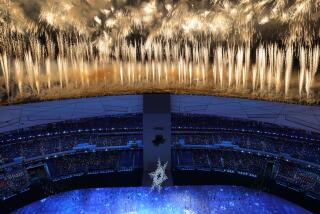Chinese savor the lingering glow of Olympic pride
- Share via
BEIJING — The spectacular fireworks were long over and the Olympic athletes had all gone home. But for Cai Shanhai and his wife, He Jingfeng, it was still a moment to savor as they stared up at the soaring steel arches of the Bird’s Nest national stadium last week.
“Our whole life, there’s been nothing like the Olympics. On TV, you can only see so much of the Bird’s Nest, but in person you can see every bit of it. It’s so grand, so grand,” said He, 67, clad in a red embroidered jacket for the occasion.
The couple -- farmers from a village in Inner Mongolia -- are hardly alone in their enthusiasm. Since the Olympic Games ended in August, some 35,000 to 40,000 visitors a day have streamed through the 91,000-seat stadium, according to ticketing officials. The smaller, whimsical Water Cube nearby draws its own share of visitors -- 20,000 to 26,000 daily.
The enormous interest in the Olympic venues signals that the collective national pride and excitement built up over the Games remains in force -- a big payoff domestically on the government’s $40-billion gamble at showcasing a more open and modern China.
The display of dazzling technology and modern infrastructure also largely succeeded in boosting China’s image internationally, scholars say.
“It is the first time that 4.5 billion people in the world saw on TV what China really looked like,” said Jin Yuanpu, professor and director of the Humanity Olympic Study Center of Renmin University.
The government fulfilled its promise to clean up the air pollution and reduce its snarled traffic for the Olympics. But for those who had hoped the Games would quicken progress on human rights and media freedom, lasting changes have been less clear. Beijing did announce that relaxed restrictions on reporting by foreign journalists, already in place for the Olympics, would become permanent.
In a tumultuous year marked by crippling snowstorms in southern China, an uprising in Tibet and a devastating earthquake in Sichuan, the government’s success in managing the Olympics had a powerful effect on public confidence.
“It was a victory for the government’s attempt to improve China’s image,” said Ashley Esarey, a scholar at Harvard University’s Fairbank Center for Chinese Studies. “The Chinese feel they are fully on the radar of the international community.”
For the time being, the lingering feel-good aura of the Olympics can be seen in the excited crowds flocking to the modern-day architectural marvels that rival some of Beijing’s more historic tourist sights. By one measure -- attendance -- the Olympic venues have already surpassed them.
During the weeklong national holiday in October known as Golden Week, the Olympic Green -- home to both the Water Cube and the Bird’s Nest -- had 2.42 million visitors. By comparison, the Forbidden City only got 625,000 people during the same period, according to state media.
The Water Cube is due to become a public pool, and there are tentative plans for the Beijing Guoan football club to make the Bird’s Nest stadium its home field.
For the last couple months, dozens of tour buses have filled up rows in the stadium parking lot. Farmers line up next to uniformed students to pay for the privilege of strolling through Olympic venues many had only seen on the small screen.
More to Read
Sign up for Essential California
The most important California stories and recommendations in your inbox every morning.
You may occasionally receive promotional content from the Los Angeles Times.













